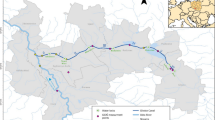Abstract—
The intense pollution due to increased anthropogenic load on the water catchment areas is a problem of small rivers. Changes in the hydrochemical regime of small rivers have an impact on large rivers as well, since the former feed the latter with transfer of pollutants from the land. Agricultural and communal water pollution of small rivers can be the cause of degradation of the river system. Therefore, systematic monitoring and comprehensive evaluation of the water quality of small rivers against the background of climatic changes and low water is an urgent problem for the water management of Ukraine. This study is aimed at assessing the ecological state of the Umanka River (the left tributary of the Yatran’ River) in a certain period of time, which makes it possible to follow changes in water quality under the influence of anthropogenic factors and natural and climatic conditions of low water. Based on the results of analytical measurements of water samples of the Umanka River bed, the following block indices of water quality are calculated: index I1 of contamination by the components of the saline composition (the sum of the Cl– and \({\text{SO}}_{4}^{{2 - }}\) ions); ecological and sanitary index I2 (\({\text{NH}}_{4}^{ + }\), \({\text{NO}}_{2}^{ - }\), \({\text{NO}}_{3}^{ - }\), PO, and pH); and index I3 of specific indicators of toxic action (Fetot, Cd, Pb, Cu, and Zn). According to hydrochemical parameters, the Umanka River water—which is a potential source of drinking water supply—is contaminated with nitrogen compounds \({\text{NH}}_{4}^{ + }\), \({\text{NO}}_{2}^{ - }\), and \({\text{NO}}_{3}^{ - }\), and with Cd and Pb, and has a high level of permanganate oxidation exceeding the fourth class level of surface water quality. A comprehensive ecological assessment of the river water with values ranging from 3.51 to 4.36 along the stream is carried out, and the water quality is characterized as transitioning from “good” and “fairly pure” to “satisfactory” and “slightly polluted” with a tendency to approach “mediocre” and “moderately polluted”, while the Umanka River water in 2004 was classified as “good” and “fairly pure”.


Similar content being viewed by others
REFERENCES
Normatov, I.S., Goncharuk, V.V., Shermatov, N., and Normatov P.I., The hydrochemistry of High-Mountain Pamir rivers: Factors affecting the chemical composition of the Vanj River, a tributary of the transboundary Panj River (Tajikistan), J. Water, Chem.Technol., 2021, vol. 43, no. 4, pp. 348–354. https://doi.org/10.3103/S1063455X2104010X
Nesterova, O.V., Sharkov, V.V., Zhuravleva, O.A., and Nesterov, Ya.S., Problems of small river basins, Vestn. Pridnepr. Gos. Akad. Stroit. Arkhitekt., 2019, no. 5, pp. 67–74.
Strokal, M., Kroese, C., Kopilevych, V.A., and Voytenko, L.V., Reducing future nutrient imputs to the Black Sea, Sci. Total Environ., 2014, vol. 466–467, pp. 253–264. https://doi.org/10.1016/j.scitotenv.2013.07.004
Kumar, V., Sharma, A., Bhardwaj, R., and Ashwani Kumar, T., Water quality of River Beas, India, and its correlation with reflectance data, J. Water, Chem.Technol., 2020, vol. 42, no. 2, pp. 134–141. https://doi.org/10.3103/S1063455X2002006X
Khomenko, O. and Gaidar, I., Analysis of the ecological state of small rivers in the Cherkasy region (on the example of the city of Zolotonoshka), Ekol. Bezop., 2010, no. 2(10), pp. 39–42.
Yatsyk, A.V., Yatsik, I.A., Gopchak, I.V., and Basyuk, T.A., Assessment of the ecological state of surface waters of small rivers in the basin of the Western Bug city according to the level of pollution (by the example of the city of Gapa), Vestn. Agrar. Nauki, 2020, no. 1(802), pp. 75–80. https://doi.org/10.31073/agrovisnyk202001-11
DSTU 4808:2007: Sources of Centralized Drinking Water Supply. Hygienic and Environmental Requirements for Water Quality and Selection Rules, Kyiv, 2007.
Basov, M.V. and Sysa, L.V., Comprehensive assessment of the water quality of small rivers on the example of the left tributaries of the Ros River, Vestn. L’vov. Gos. Univ. Bezop. Zhiznedeyat., 2015, no. 12, pp. 100–106.
Plan upravleniya rechnym basseinom Yuzhnogo Buga: analiz i pervoocherednye meropriyatiya (Southern Bug River Basin Management Plan: Analysis and Priority Actions), Afanas’ev, S., Bedz’, N., Bodnarchuk, T., et al., Eds., Kyiv: Interservis, 201. https://mk-vodres.davr.gov.ua/sites/default/files/Bug_plan_final_2.pdf.
Kozinskaya, I.P., Sytnik, O.I., Timets, O.V., Sovgira, S.V., Goncharenko, G.E., Babii, Yu.A., Kravtsova, I.V., Polovka, S.G., Kugai, M.S., and Nepotenko, T.M., Geografiya Umanshchiny (Geography of Uman Region), Kiev: Interlink, 2006.
Berchak, V.S., Anthropogenic landscapes of the Umanka River valley, Nauchn. Zap. Vinnits. Gos. Pedagog. Univ. im. M. Kotsyubinskogo, Ser. Geogr., 2014, no. 26, pp. 98–107.
DSTU ISO 5667-6:2009 (ISO 5667-6:2014): Water Quality. Sampling. Part 6: Guidance on Sampling of Rivers and Streams, Kiev, 2012.
Regional report on the state of the environment in the Cherkasy region in 2020, Cherkassy: Upr. Ekol. Prirod. Resur., 2021.
Kopilevich, V.A., Surovtsev, I.V., Galimova, V.M., and Kozak, K.G., MSP 081/36-0790-11: Method for Measuring the Mass Concentration of Lead, Copper, Zinc, and Cadmium in Water by Inversion Chronopotentiometry, Kyiv, 2011.
Romanenko, V.D., Zhukinskii, V.M., Oksiyuk, O.P., and Yatsik, A.V., Metodika ekologicheskoi otsenki kachestva poverkhnostnykh vod po sootvetstvuyushchim kategoriyam (Methodology for Environmental Assessment of Surface Water Quality for the Relevant Categories), Kyiv: Simvol-T, 1998.
Paranyak, R.P., Vasil’tseva, L.P., and Makukh, Kh.I., Ways for heavy metals to enter the environment and their impact on living organisms, Biol. Tvarin, 2007, vol. 9, no. 3, pp. 83–89.
Nabivanets, B.I., Osadchii, V.I., Osadchaya, N.M., and Nabivanets, Yu.B., Analiticheskaya khimiya poverkhnostnykh vod (Analytical Chemistry of Surface Waters), Kyiv: Nauchn. Mysl’, 2007.
Author information
Authors and Affiliations
Corresponding author
Ethics declarations
The authors declare that they have no conflicts of interest.
Additional information
Translated by O. Kadkin
About this article
Cite this article
Zalenska, Y.A., Kopilevych, V.A. Environmental Assessment of Surface Water Quality in the Umanka River Basin. J. Water Chem. Technol. 45, 496–502 (2023). https://doi.org/10.3103/S1063455X23050132
Received:
Revised:
Accepted:
Published:
Issue Date:
DOI: https://doi.org/10.3103/S1063455X23050132




